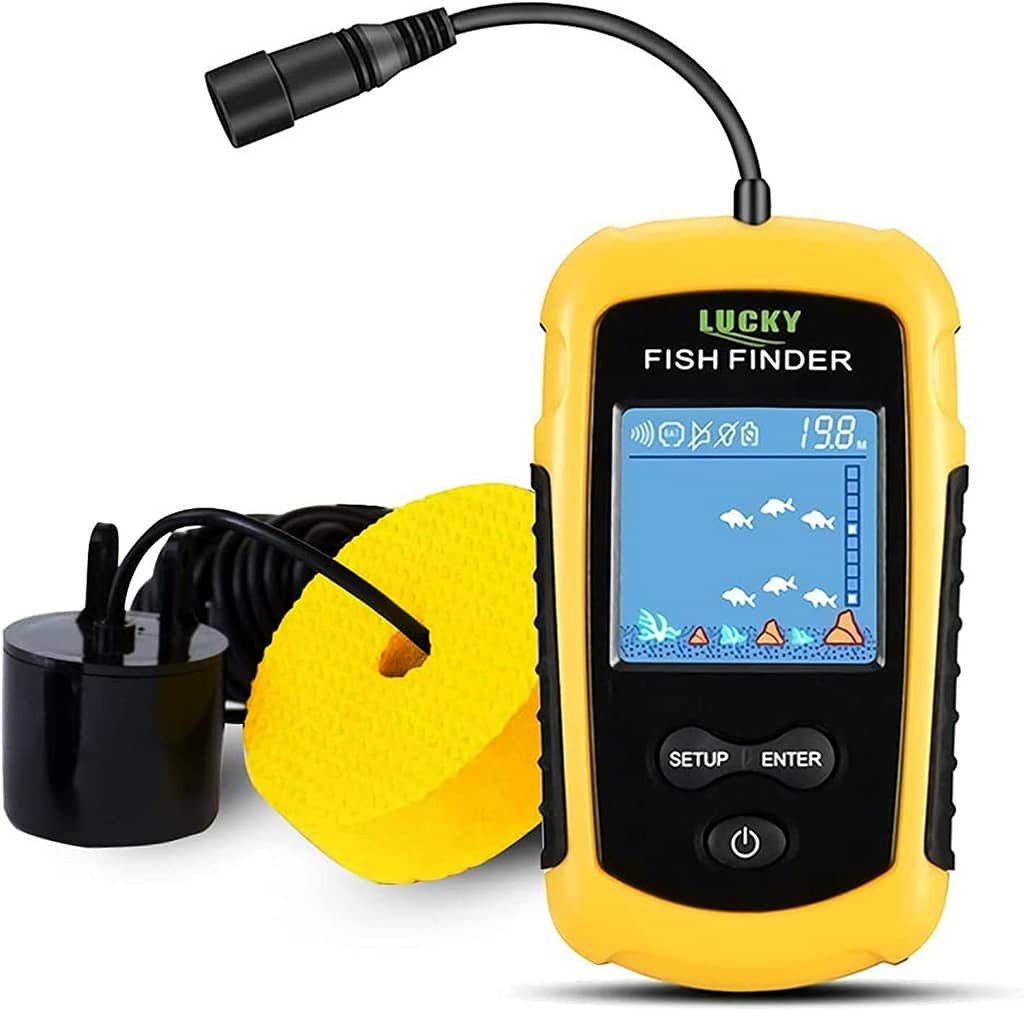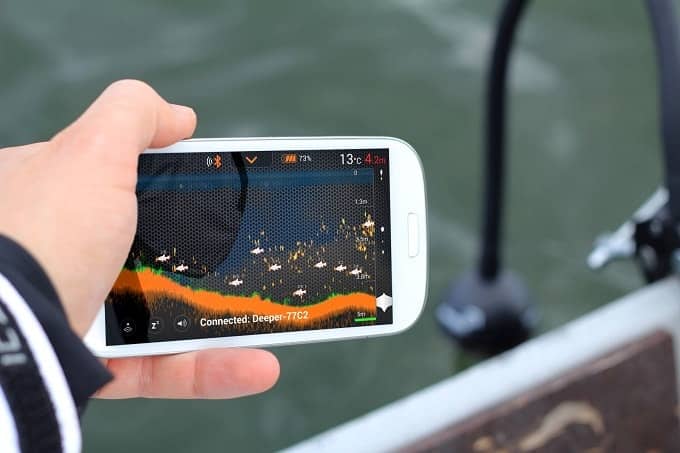A fish depth finder, also known as a fish finder or sonar, is an electronic device that uses sound waves to locate fish and other underwater objects. The device sends out a sound wave that bounces off of objects in the water and returns to the device, providing information about the depth, size, and location of fish and other underwater features.
Fish depth finders come in a variety of types and styles, from handheld devices to larger, more complex units that can be mounted on a boat. They typically include a display screen that shows a graphical representation of the underwater environment, including the depth and location of fish and other objects.
Some fish depth finders also include additional features such as GPS mapping, temperature sensors, and speed indicators, which can help anglers navigate and locate fish more effectively. With the help of a fish depth finder, anglers can better understand the underwater environment and increase their chances of catching fish.

LUCKY Portable Fish Depth Finder Water
It is a portable fish finder that could display approximate fish location and water depth. The sonar transducer can be attached to the hull of kayak or boat in order to understand the changing of water depth when you are moving by.
- Device is easy to use, easy to understand.
- Compact
- Affordable Price

Venterior Portable Rechargeable Fish Finder Wireless Sonar Sensor
No more long & heavy cable for transducer. Clear Color Screen: it comes with clear color TFT LCD display. 2 screen background colors selectable – black and white.
- Easy to use
- Portable
- waterproof.

Deeper START Smart Fish Finder – Castable Wi-Fi fish finder for recreational fishing
Easily find where your next catch is hiding with the Deeper START Fish Finder! The lightweight and sleek design makes for a seamless reel without any messy wires or fiddly external batteries required.
- Very accurate.
- The setup is quick and easy
- Graphics are clear.
Type of Fish Depth Finder?
There are several types of fish depth finders available, each with their own unique features and benefits. Here are some of the most common types:
Standalone Fish Finders
These are portable and self-contained units that include a display screen and transducer. They are typically battery-powered and can be used on any type of watercraft, from kayaks to large boats.
Combo Fish Finders
These units combine a fish finder with GPS mapping and chart plotting capabilities. They can provide anglers with detailed maps of the water, as well as information on fish locations and depth.
Networked Fish Finders
These units are designed to be part of a larger system that includes multiple displays and sensors. They can be connected to other devices, such as radar or autopilot, and provide a more comprehensive view of the underwater environment.
Portable Fish Finders
These are small, handheld units that can be carried in a tackle box or backpack. They typically include a small display screen and a transducer that can be attached to the end of a fishing line.
Ice Fishing Fish Finders
These units are specifically designed for ice fishing and can be used to locate fish under the ice. They are typically portable and easy to use, with a display screen that can be viewed through the ice.
Castable Fish Finders
These are small, ball-shaped units that can be cast into the water using a fishing rod. They include a sonar sensor that sends information back to a smartphone app, providing real-time data on fish locations and depth.
Almost, the type of fish depth finder that is best for you will depend on your fishing style and the type of water you will be fishing in. Consider your needs and preferences when selecting a fish finder, and choose a unit that provides the features and capabilities you require.
Advantages and disadvantages of Portable Fish Finders
Portable fish finders can offer several advantages and disadvantages for anglers. Here are some of the most common advantages and disadvantages of using a portable fish finder:
Advantages:
- Portability: One of the main advantages of a portable fish finder is that it can be easily carried in a tackle box or backpack, making it ideal for anglers who frequently fish in different locations or who prefer to fish from shore.
- Affordability: Portable fish finders are generally less expensive than larger, more complex units, making them a good option for anglers on a budget.
- Ease of Use: Portable fish finders are typically very easy to use, with simple controls and a straightforward interface.
- Versatility: Portable fish finders can be used on any type of watercraft, from kayaks to small boats, and can also be used for ice fishing.
Disadvantages:
- Limited Range: Portable fish finders typically have a limited range, which can make it difficult to locate fish in deeper or larger bodies of water.
- Smaller Display Screen: The display screen on a portable fish finder is typically smaller than on larger units, which can make it more difficult to see details or to read in bright sunlight.
- Less Features: Portable fish finders may not include some of the advanced features found on larger units, such as GPS mapping or networking capabilities.
- Limited Battery Life: Portable fish finders are typically battery-powered, which can limit their use time and require anglers to carry spare batteries.
Overall, portable fish finders can be a convenient and affordable option for anglers who want to locate fish in a variety of locations. However, they may have limitations in terms of range and features, and may not be suitable for all types of fishing.
How to choose a Portable Fish Finders?
When choosing a portable fish finder, there are several key factors to consider. Here are some of the most important things to keep in mind:
Frequency
The frequency of the fish finder’s transducer will determine its depth capabilities. Higher frequencies (200kHz and above) are better for shallow water fishing, while lower frequencies (50kHz and below) are better for deeper water fishing.
Power
The power of the fish finder will determine its range and sensitivity. Higher power fish finders will have a longer range and be able to detect smaller fish.
Display
The display screen on the fish finder should be easy to read in all lighting conditions, with a high resolution and clear contrast.
Battery Life
Portable fish finders are typically battery-powered, so it is important to choose a unit with a long battery life to ensure it lasts through a full day of fishing.
Portability
Consider the size and weight of the fish finder, as well as any carrying case or accessories, to ensure it is easy to transport and store.
Ease of Use
The fish finder should have simple controls and a straightforward interface, with intuitive menus and settings.
Additional Features
Consider any additional features that may be useful for your fishing style, such as GPS mapping, depth alarms, or fish alarms.
Budget
Determine your budget and choose a fish finder that provides the features and capabilities you need within your price range.
Choosing a portable fish finder that meets your specific needs and preferences will depend on several factors. Consider your fishing style, the type of water you will be fishing in, and any additional features that may be useful, to find the best portable fish finder for you.




